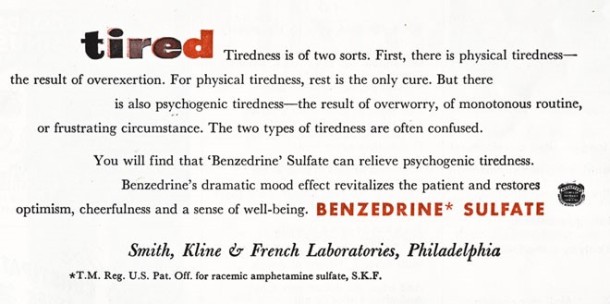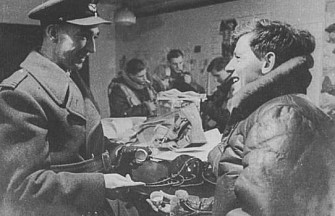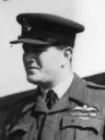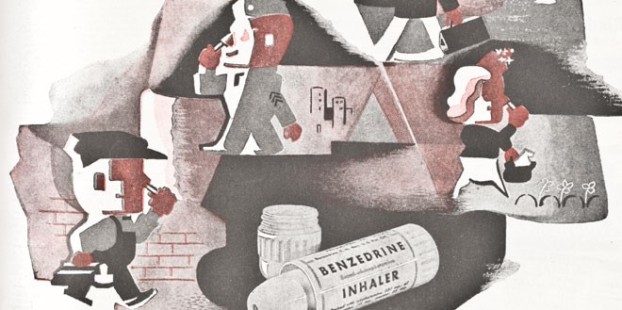Stimulant & Performance-Enhancing Drugs ~ WW2
The Airman’s – Ups & Downs –
In 1934, when Smith, Kline and French began selling Amphetamine as an inhaler under the trade name Benzedrine as a decongestant. “One of the fundamental Drugs in Medicine,” SKF’s advertising declared, with Physicians and the Public inclined to agree. Benzedrine Sulphate the 1st Prescription Drug for treating “discouragement” – was on the way to Medical Stardom. As early as 1919, Akira Ogata synthesized Methamphetamine via reduction of Ephedrine using red phosphorus & iodine. Later, the Chemists Hauschild & Dobke from the German Pharmaceutical Company Temmler developed an easier method for converting Ephedrine to Methamphetamine. As a result, it was possible for Temmler to Market it on a large scale as a non-prescription Drug under the Trade Name Pervitin (methamphetamine hydrochloride). During WW2, amphetamine and Methamphetamine were used extensively by both the Allied & Axis Forces for their stimulant & performance-enhancing effects. Pervitin was commonly used by the German & Finnish Militaries.

It was widely distributed across German Military Ranks and divisions, from Elite Forces to Tank Crews & Aircraft Personnel, with many millions of Tablets being distributed throughout the War for its performance enhancing stimulant effects and to induce extended wakefulness. Its use by German Tank (Panzer) Crews also led to it being known as Panzerschokolade (“Tank-Chocolates”). It was also colloquially known among German Luftwaffe Pilots as Stuka-Tabletten (“Stuka-Tablets”) and Hermann-Göring-Pillen (“Herman-Göring-Pills”). More than 35M 3-milligram Doses of Pervitin were manufactured for the German Army & Air Force between April & July 1940. From 1942 until his death in 1945, Adolf Hitler was given intravenous injections of Methamphetamine by his personal Physician Theodor Morell.
As with the rest of the world at the time, the Side Effects of Methamphetamine were not well studied, and regulation was not deemed necessary. In the 1940s & 1950s, the Drug was widely administered to Japanese Industrial Workers to increase their Productivity. British Troops used 72M Amphetamine Tablets in WW2. The RAF used so many that “Methedrine won the Battle of Britain” according to 1 Report. Misuse of Methamphetamine may cause sudden death and serious cardiovascular adverse effects.
Up, down, flying around, looping the loop & defying the ground………………..

Medical Officer & Dispenser
The 2 –Gunners were the ones most likely to doze off because of their long periods of inactivity. Doing a Visual Search on a pitch-black Night kind of hypnotized and, along with the drone of the Engines, induced sleep in most normal Gunners. Most were too damned scared to close their eyes. In fact they stared into the darkness so hard that some couldn’t close their eyes for a least 4-hours after Landing. Eyelids were thought to be stuck under the edge of their Helmets. All were advised, that they could have ‘Wakey-Wakey’ Tablets if we felt we needed them, but were also advised not to take them if we did not need them. They were Caffeine Tablets and also acted as a Diuretic. You know what that meant and nobody enjoyed that Parade at 20,000ft and – 40⁰! The Benzedrine some people mentioned was in the form of Tablets in our Escape Kits and to be used Only in the Utmost Urgency, as in running from Pursuers to cover lots of Ground. Our Medics advised us if we used them and did push ourselves to the Limit to Escape, we were to realise that we would be completely worn out and to make sure to find someplace where we could Sleep around the Clock.
‘Wakey-wakey’ pills were issued to Bomber Crews, and were often hoarded for their all too infrequent spells of Leave!
Caffeine is also effective at reversing some of the effects of Fatigue. It compares favourably to Amphetamine in improving Cognitive performance but is less effective in maintaining Alertness. Based purely on efficacy, it is a 2nd choice to Amphetamine. Due to its low abuse potential & wide availability, however, Caffeine still offers significant utility (especially in Ground Crew Personnel). In a great many instances the difference between sleepiness & alertness is the difference between life & death. A man who dozes off in a Jungle Foxhole may never wake up again. It is therefore understandable, in light of the unprecedented human Exertion required by modern Warfare, that Military Commanders sought a solution to the problem of Combat Fatigue. The Military looked to Psychiatry for a solution; they found an answer in Amphetamine.
The British War Office discovered that between April and June 1940, at the height of the German Blitzkrieg across France & the Low Countries, the Wehrmacht had consumed 35M 3mg Tablets of their own Synthesized Adrenaline, Methamphetamine, which was marketed by a German Pharmaceutical Company under the name “Pervitin.” The Allies assumed that Stimulants had played an important role in Germany’s Military success, and Britain & the US responded with their own Field Tests on the effects of Amphetamines on Soldiers’ performance. The LMH Archives (Laurier Military History) contain Records of British Instructions on the use of Benzedrine in War Operations. The Instructions recommend that Soldiers should ingest 5mg-10mg of Benzedrine Sulphate every 5 to 6-hrs, not exceeding 20mg per day, issued at the discretion of the Unit Medical Officer when sleep was severely limited for several days. While Benzedrine was noted for its positive effect on Alertness, the instructions caution that Benzedrine should not be used for its Euphoric effects, since “changes in mood are associated with irresponsibility, garrulousness, etc….” Benzedrine’s ability to “relieve feelings of dullness & inadequacy” made it susceptible to abuse. Instead, the instructions recommended Benzedrine for the Infantry when exhausted Troops were required to engage in Work or Combat, and to Transport Drivers & Dispatch Riders who needed to overcome the dangerous effect of monotony, lighting, and other conditions of Driviing. However, much like the Public’s discovery of Benzedrine’s mood-altering properties, Military Commanders were aware of Benzedrine’s ability to increase confidence, aggression & ‘morale’ among Soldiers.
Amphetamine was given to Allied Bomber Pilots during WW2 to sustain them by fighting off Fatigue and enhancing Focus during Long Flights. The greatest Experiment in Amphetamine-based enhancement. In 1939 the Blitzkrieg’s success was attributed partly to the use of Pervitin – Methamphetamine – among German Soldiers. By mid-1940 the British & American Militaries had begun their own respective Chemical investigations. Both eventually settled on Benzedrine to combat Fatigue and boost Morale. The Drug proved especially popular among Pilots and Air Crews, who often had to Fly long, gruelling Bombing Raids late into the Night. By 1943 a package of Benzedrine Pills had its place in the Emergency Kit of every American Bomber. Two years later a survey of European Fighter Pilots who frequently flew Long Missions showed that around 15% frequently used Benzedrine. Methamphetamine produced similar results; ironically, the accompanying Recklessness, along with worries about Addiction, quickly led the Germans to discourage its use in the Field. American & British Forces, however, used Amphetamine throughout the War for its effects on Mood & Morale: it kept up the “Fighting Spirit.” The British later concluded the subjective boost wasn’t worth the potentially Lethal side effects. WW2 did little to hurt the appetite for Amphetamine. In fact, the increased exposure on the Battlefield likely helped, and by 1945 SKF produced a 1M Benzedrine Tablets a day.
Roland Winfield Medical Officer of the RAF was Studying the Effects of Benzedrine on Long-range Bomber Command Missions when the Bomber Pilot he was observing suddenly plunged his Aircraft below the cover of Clouds, into heavy anti-Aircraft Fire, in order to “press home the Attack.” The Pilot scored a Direct Hit. Winfield recommended Benzedrine for every RAF Mission, for the “Determination” & “Aggression” that it imparted. By early 1942, Smith, Kline & French was supplying large quantities of Benzedrine to the RAF. Likewise, a British War Memorandum in 1943 titled A Guide to the Preservation of Life at Sea after Shipwreck suggested that Shipwrecked Sailors use Benzedrine to “lessen feelings of fatigue & exhaustion, promote alertness, raise the spirits, and prolong the will to ‘hang on and live’.” That same year the Army Supply Service provided Commanders with Packets of 6 Benzedrine ‘Pep Pills’ for each of their Soldiers. US Marines relied on Benzedrine during the invasion of Tarawa in November 1943, and Paratroopers used the stimulant during the rigorous D-Day Landings in June 1944.
Certainly Sir Stirling Moss admitted that the ‘Wakey-Wakey’ Pills he was issued on the 1955 Mille Miglia worked particularly well. He drove the entire 1000-miles non-stop, took part in the Awards Party, then he drove from Italy to Stuttgart for a Celebration Dinner with the Mercedes Benz Management, before eventually deciding he needed a good night’s sleep!
Benny & The Jets
During the Persian Gulf War, Amphetamine became the Drug of Choice for American Bomber Pilots, being used on a voluntary basis by roughly half of US Air Force Pilots. The Tarnak Farm incident, in which an American F-16 Pilot killed several friendly Canadian Soldiers on the Ground, was blamed by the Pilot on his use of Amphetamine. Slang terms for Methamphetamine, especially common among illicit users, are numerous and vary from region to region. Some names are Wakey Wakey Pills, Pep Pills, Bennies, Crystal Meth, Meth, Speed, Crystal, Ice, Shards, Glass, Jib, Crank, Tweak, Rock, Tina, Fast & Cold. Terms vary by region & subculture. Eventually, as the Addictive Properties of the Drugs became known, Governments began to place strict controls on the sale of the Drugs. For example, during the early 1970s in the United States, Amphetamine became a Schedule II Controlled Substance under the Controlled Substances Act. Despite strict Government Controls, both Amphetamine & Methamphetamine have still been used Legally or Illicitly by individuals from a variety of backgrounds for different purposes. It was not until 1986 that Pervitin became a controlled substance, requiring a special prescription to obtain.
Long-term Methamphetamine Abuse has many negative consequences, including addiction. Addiction is a chronic, relapsing disease, characterised by compulsive drug seeking and use and accompanied by functional and molecular changes in the brain. As is the case with many drugs, tolerance to Methamphetamine’s pleasurable effects develops when it is taken repeatedly. Abusers often need to take higher doses of the Drug, take it more frequently, or change how they take it in an effort to get the desired effect. Chronic Methamphetamine abusers may develop difficulty feeling any pleasure other than that provided by the Drug, fueling further abuse. Withdrawal from Methamphetamine occurs when a chronic abuser stops taking the Drug; symptoms of withdrawal include Depression, Anxiety, Fatigue, and an intense craving for the Drug.
In addition to being Addicted to Methamphetamine, people who use Methamphetamine long term may exhibit symptoms that can include significant Anxiety, Confusion, Insomnia, Mood disturbances, & Violent behaviour. They also may display a number of Psychotic features, including Paranoia, Visual & Auditory Hallucinations & Delusions (for example, the sensation of insects creeping under the Skin). Psychotic symptoms can sometimes last for months or years after a person has quit using Methamphetamine, and Stress has been shown to precipitate spontaneous recurrence of Methamphetamine Psychosis in people who use Methamphetamine and have previously experienced Psychosis. These and other problems reflect significant changes in the brain caused by misuse of Methamphetamine. Neuroimaging Studies have demonstrated alterations in the activity of the Dopamine System that are associated with reduced motor speed and impaired verbal learning. Studies in chronic Methamphetamine users have also revealed severe structural & functional changes in areas of the brain associated with Emotion & Memory, which may account for many of the Emotional & cognitive problems observed in these individuals. Research in primate models has found that Methamphetamine alters brain structures involved in decision-making and impairs the ability to suppress habitual behaviors that have become useless or counterproductive. The 2 effects were correlated, suggesting that the structural change underlies the decline in Mental flexibility. These changes in brain structure & function could explain why Methamphetamine Addiction is so hard to treat and has a significant chance of relapse early in Treatment.


